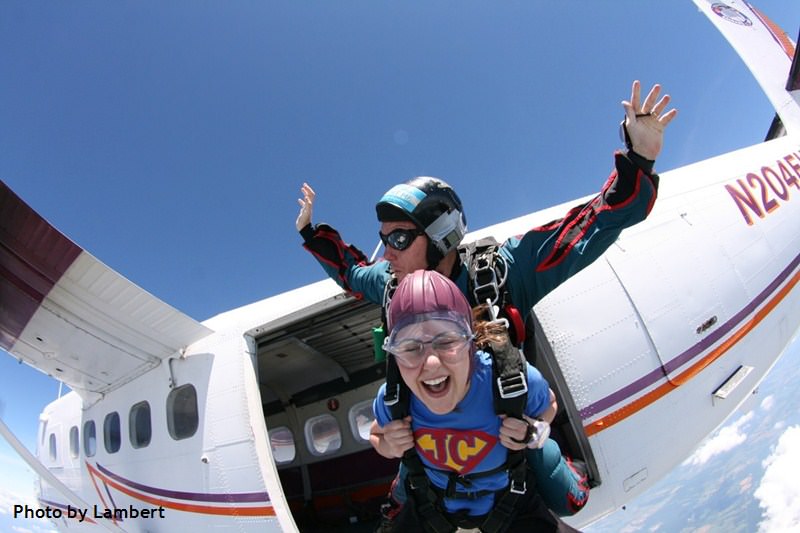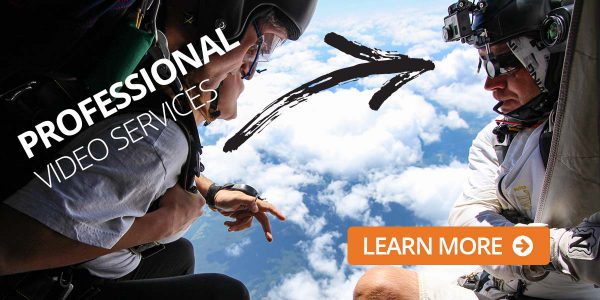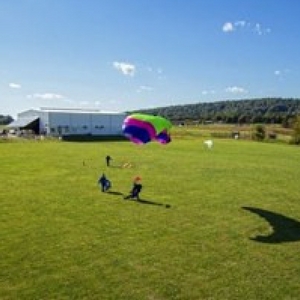
Skydiving Exits: Can I Do Backflips and Spins?
Tuesday, October 31, 2023
- Skydive Orange
- 10/31/23
- 0
- Skydiving Information
How do you picture skydiving for the first time? Do you imagine cutting a picture-perfect backflip from the airplane? Or maybe tucking into a series of acrobatic skydiving tricks spinning, tumbling, and flipping through the sky with reckless abandon? It might seem like the logical thing to do. This is skydiving after all, why not go full send!? But when it comes to skydiving exits, safety is the top priority. A safe and controlled exit sets the tone for the rest of the skydive, so choosing the right exit for your skydive is key to a successful jump.
If exits are so important, are there exit techniques in skydiving? There sure are! Read on to find out what makes a safe airplane exit and to learn about some of the best, and safest, skydiving exits out there!
Safety First
Two common questions skydiving instructors get from the bravest of first-time skydivers are, “can you do a backflip while skydiving?” and “can you do spins while skydiving?” We love taking life by the horns too, but creative skydiving exits and first-time tandem skydiving just don’t mix. Skydiving is all about mitigating risk, so safety is always first and foremost. That’s why there are prescribed, safe tandem skydiving exits for beginners.
The manufacturers of tandem skydiving equipment have certain rules in place regarding the type of skydiving exits an instructor can do. The two approved exits for the proper use of tandem skydiving equipment are a diving exit and a poised exit.
On a diving exit, you leave the door as if you’re Superman flying toward the back of the airplane. Because you exit the plane in an orientation with your head low, it feels a little like the sensation of diving into a pool or sliding tummy first down a slide.
A poised exit requires the opposite orientation of a diving exit – that is, head high. For a poised skydiving exit, you face out of the door and are slightly turned toward the front of the aircraft as you leave the plane. If you keep your chin up while you do this exit, you will be able to see the aircraft flying above you. Talk about a cool visual!
The reason these two exits are the only ones officially allowed by tandem jumpers is that they are proven to be the most stable. Most of the body’s surface area is facing into the relative wind and the tandem instructor has the most control over what’s happening on the jump.
What Makes A Good Skydiving Exit?
There are a lot of factors that go into a successful exit, but a few stand out as the most important.
- Arch
You’ll hear this one a lot during your time at the dropzone. The main focus of your tandem training is going to be perfecting your arch position, and that’s because this one very important move is what will keep you stable throughout your entire jump. And it’s especially relevant on exit. - Control
Exiting the airplane is a rush of adrenaline, excitement, sensory overload, and maybe even fear. But through all that, it’s crucial to maintain control. Your tandem instructor has trained countless jumps and hours to have command over what both of your bodies are doing during the jump, but it’s extremely helpful if you can contribute to the smooth calmness that makes a skydive so perfect. - Awareness
In order to be in control, you have to be aware. It’s okay to feel whatever exiting an airplane makes you feel, but being aware of your surroundings and appropriately reacting to what’s happening will make the whole process more enjoyable for everyone. - Spacing
You probably won’t notice this when you’re climbing out, but your instructor is going to be very careful to leave ample space between you and the people who exited before you so as to avoid any collisions. We actually calculate the time between jumpers based on the wind speed and how fast the airplane is flying, but you don’t have to worry about that! Just know that your instructor has it all under control. - Spot
As maneuverable as our parachutes are, there’s only so much we can do without an engine. Exiting the airplane within a certain distance of the dropzone is important to safely landing back where we started, and your instructor will have all of that planned out before you even get into the airplane.
The Time To Huck It Will Come!
For your first several skydives, whether as a tandem skydiver or a student skydiver, your primary skydiving exit objective is to achieve stability as quickly as possible. This allows you to focus more on what is going on around you and, especially as a skydiving student, gives you ample time to practice your freefall maneuvers.
But part of the fun that comes as your skydiving story unfolds is the chance to really “dive in” to skydiving exits. (See what we did there?)
As you become more skilled, you’ll have the opportunity to discover that, while it seems simple enough to get out of the plane, you can get quite creative and incredibly technical with different skydiving exits.
There are some fun and unique skydiving exit experiences to explore as you learn more and more about how to fly your body out of the airplane.
Four Favorite Fun Skydiving Exits
Raft Dive
Tailgate aircraft are often “the belle of the ball” at many large skydiving events (in the biz we call these events “boogies”). Rather than a side door, these aircraft have a rear door that opens much like the tailgate on a truck. Because of this configuration, tailgate aircraft are perfect for some really unique skydiving exits … like the infamous raft dive!
For this exit, you literally have an inflatable raft or mega pool float (we’ve seen everything from inflatable bulls to a perfectly posh pegasus) that you ride off the back of the aircraft. Trust us, a raft dive gives fun a whole new meaning! And it makes for some great video footage!
Horny Gorilla
To tell the truth, we don’t know where the name for this type of skydiving exit originated, but we do know it’s a real hoot to do! For a horny gorilla exit, everyone flies in a sitting position and entwines/hooks their legs together. If you get it just right, you’ll be facing off with all your friends on a rowdy ride that feels like a spinning top. You get bonus points if you beat your chest like a gorilla while it’s happening!
Hanging from the Strut of a Helicopter
Achieving a Class B skydiving license affords an individual the chance to jump specialty aircraft such as helicopters and hot air balloons. While climbing onto the strut of a hovering helicopter requires a fair amount of physical dexterity and coordination, it’s honestly one of the most epic skydiving exits. Another notable highlight of a helicopter skydiving exit is that because the helicopter has no significant forward drive, when you let go of the strut you experience a sensation of complete weightlessness before your body picks up speed and reaches terminal velocity.
Wingsuit Rodeo
If you ever dreamed of being a skydiving cowboy, here’s your chance! On a wingsuit rodeo, a wingsuiter and a non-suited skydiver exit the aircraft with the non-suited skydiver behind the wingsuiter. The person then holds on like they would a rodeo bull for one wild, zippy ride! Please note, the wingsuiter in this dynamic should be a competent and skilled wingsuit pilot.
The options for interesting skydiving exits are as vast as the horizon! But remember, before moving on to complex air acrobatics, it’s important to have a handle on the basics. Whether you’re making a tandem skydive or well on your way with your student progression, at Skydive Orange we will show you how it’s done! Ready? Set. Book your skydive and go, Go, GO! Blue skies.
The largest tandem skydiving center near Northern Virginia, Washington D.C. and Maryland.
Copyright © 2025, Skydive Orange, All Rights Reserved.
DropZone Web Design & Marketing by Beyond Marketing, LLC



